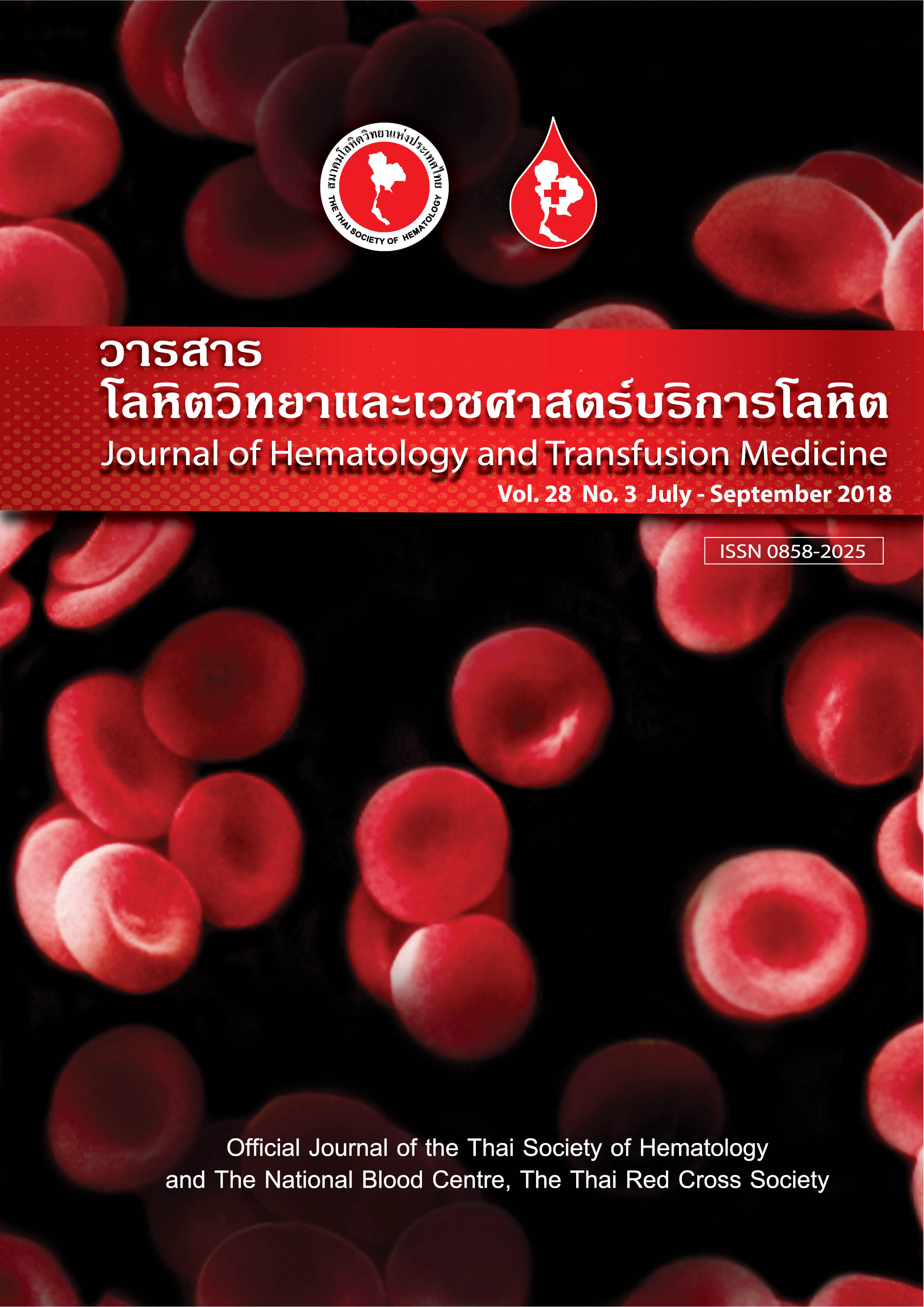The Efficacy of empirical antibiotics for febrile neutropenia in patients with acute myeloid leukemia
คำสำคัญ:
febrile neutropenia,, acute myeloid leukemia, AML, Empirical antibioticบทคัดย่อ
Objective The primary objective was to determine rate of clinical response to empirical antibiotics for the treatment of FN in AML patient receiving chemotherapy.
Materials and methods This is retrospective cohort study, conducted among patients with AML who were treated at Chiang Mai University hospital between January 2007 and May 2014.
Results There were 260 episodes of FN in 70 AML patients. Majority was female (56%) with a median age of 45 years. Specific sites of infection were not found in 58% of FN episodes while bacteremia was detected in 22%. The most common organisms isolated from blood were Escherichia coli (22%) while extended spectrum beta-lactamase (ESBL) producing gram negative bacilli was detected in10.5%. Ceftazidime combined with amikacin or ciprofloxacin was the most common prescribed empirical antibiotics (71.9%). The response rate after empirical antibiotics were comparable after treated with ceftazidime & amikacin/ciprofloxacin (66%), piperacillin/tazobactam (60%) and Imipenam/meropenam (73%) (P=.68). In FN episodes with pathologic organisms identified, there was a correlation between the spectrum of antibiotic coverage and the clinical response (P=.048). From multivariate analysis, factors with a trend to predict a poor response to empirical antibiotics were FN during induction (OR 2.4; 95% CI 0.95-6.20, P=.06) and uncovered spectrum of empirical antibiotics to pathogenic bacteria (OR 2.6; 95% CI 0.95-7.58, P=.06).
Conclusions All three commonly prescribed empirical antibiotics provided comparable clinical response rate. Empirical antibiotics with coverage spectrum to pathogenic organisms improved the clinical response in AML patients with FN.
Downloads
เอกสารอ้างอิง
2. Freifeld A, Bow E, Sepkowitz K, Boeckh M, Ito J, Mullen C et al. Clinical Practice Guideline for the Use of Antimicrobial Agents in Neutropenic Patients with Cancer: 2010 Update by the Infectious Diseases Society of America. CID 2011;52:e56-e93
3. Paul M, Soares-Weiser K, Grozinsky S, et al. Beta-lactam versus betalactam-aminoglycoside combination therapy in cancer patients with neutropaenia. Cochrane Database Syst Rev 2003: CD003038.
4. Napier E. Ceftazidime for Neutropenic Fevers: Is It Still an Appropriate Choice? J Adv Pract Oncol. 2013;4:394–401
5. Hughes W, Armstrong D, Bodey G, Bow E, Brown A, Calandra T, et al. 2002 Guidelines for the Use of Antimicrobial Agents in Neutropenic Patients with Cancer. CID 2002;33:730–751
6. Paul M, Yahav D, Bivas A, Fraser A, Leibovici L. Anti-pseudomonal beta-lactams for the initial, empirical, treatment of febrile neutropenia: Comparison of beta-lactams. Cochrane Database of Systematic Reviews 2010;11:1–158
7. Anaissie J, Fainstein V, Bodey P, Rolston K, Elting L, Kantarjian H, McCredie K. Randomized trial of beta-lactam regimens in febrile neutropenic cancer patients. Am J Med. 1988;84:581–589
8. Rolston V, Berkey P, Bodey P, Anaissie J, Khardori M, Joshi H. A comparison of imipenem to ceftazidime with or without amikacin as empiric therapy in febrile neutropenic patients. Arch Int Med. 1992;152:283–291
9. Feld R, DePauw B, Berman S, Keating A, Ho W. Meropenem versus ceftazidime in the treatment of cancer patients with febrile neutropenia: a randomized, double-blind trial. J Clin Oncol. 2000;18:3690–3698
10. Cometta A, Calandra T, Gaya H, Zinner S H, de Bock R, Del Favero A, et al.. Monotherapy with meropenem versus combination therapy with ceftazidime plus amikacin as empiric therapy for fever in granulocytopenic patients with cancer. The International Antimicrobial Therapy Cooperative Group of the European Organization for Research and Treatment of Cancer and the Gruppo Italiano Malattie Ematologiche Maligne dell'Adulto Infection Program. AAC. 1996;40:1108–111



